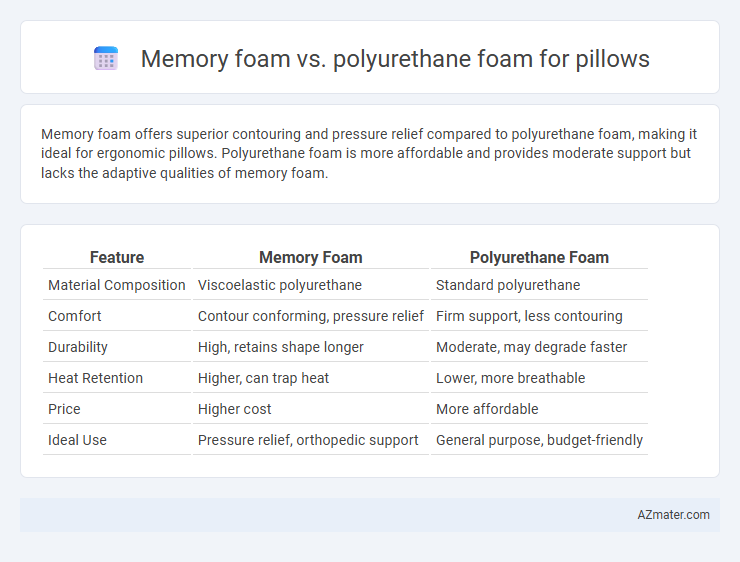Memory foam offers superior contouring and pressure relief compared to polyurethane foam, making it ideal for ergonomic pillows. Polyurethane foam is more affordable and provides moderate support but lacks the adaptive qualities of memory foam.
Table of Comparison
| Feature | Memory Foam | Polyurethane Foam |
|---|---|---|
| Material Composition | Viscoelastic polyurethane | Standard polyurethane |
| Comfort | Contour conforming, pressure relief | Firm support, less contouring |
| Durability | High, retains shape longer | Moderate, may degrade faster |
| Heat Retention | Higher, can trap heat | Lower, more breathable |
| Price | Higher cost | More affordable |
| Ideal Use | Pressure relief, orthopedic support | General purpose, budget-friendly |
Introduction to Memory Foam and Polyurethane Foam
Memory foam, a viscoelastic material known for its contouring properties and pressure relief, reacts to body heat and weight, providing personalized support ideal for pillows. Polyurethane foam, a versatile and lightweight foam, offers varying density options and quicker responsiveness but typically lacks the same adaptive comfort as memory foam. Choosing between them depends on preferences for softness, support, and heat retention in pillow performance.
Composition and Material Differences
Memory foam is primarily made from viscoelastic polyurethane combined with additional chemicals to enhance density and viscosity, providing contouring support and pressure relief. Polyurethane foam consists of a polymer matrix derived from petrochemicals with varied densities, offering a more buoyant and less conforming feel. The key material difference lies in memory foam's slow response to pressure and heat sensitivity compared to the faster response and lighter weight of standard polyurethane foam.
Support and Comfort Comparison
Memory foam pillows provide superior contouring support by conforming closely to the head and neck, reducing pressure points and promoting spinal alignment. Polyurethane foam pillows offer firmer, less adaptive support, which may feel less comfortable for side sleepers but provide adequate firmness for those preferring a solid pillow structure. The viscoelastic properties of memory foam enhance comfort through heat sensitivity and pressure responsiveness, while polyurethane foam maintains a consistent density without significant contouring effects.
Pressure Relief Capabilities
Memory foam pillows excel in pressure relief by conforming closely to the shape of the head and neck, evenly distributing weight and reducing stress on pressure points. Polyurethane foam pillows offer basic cushioning but lack the adaptive contouring properties of memory foam, resulting in less effective pressure alleviation. For users seeking enhanced pressure relief, memory foam provides superior comfort and support compared to standard polyurethane foam.
Durability and Longevity
Memory foam pillows offer superior durability and longevity due to their viscoelastic properties, which allow them to retain shape and support over time without significant degradation. Polyurethane foam pillows tend to wear out faster, compressing and losing resilience more quickly under regular use. The higher density of memory foam correlates with extended lifespan, making it a more cost-effective choice for long-term comfort in pillows.
Temperature Regulation and Breathability
Memory foam pillows often retain heat due to their dense structure, leading to less effective temperature regulation and reduced breathability, which may cause discomfort during hot nights. Polyurethane foam pillows typically offer better airflow and enhanced breathability because of their open-cell structure, promoting cooler sleep conditions. Selecting a pillow with high-density polyurethane foam can significantly improve temperature regulation and moisture-wicking properties compared to memory foam options.
Allergens and Health Considerations
Memory foam pillows, made from viscoelastic polyurethane, resist dust mites and allergens due to their dense structure, making them suitable for allergy sufferers. Polyurethane foam pillows, while more breathable, may harbor dust mites and release volatile organic compounds (VOCs) that can trigger respiratory issues. Choosing hypoallergenic memory foam with CertiPUR-US certification ensures reduced chemical exposure and better health outcomes for sensitive individuals.
Price Differences and Value for Money
Memory foam pillows typically cost more than polyurethane foam pillows due to their advanced viscoelastic properties that offer superior support and pressure relief. Polyurethane foam pillows are more affordable but may lack durability and comfort compared to memory foam, making them less cost-effective in the long run. When evaluating value for money, memory foam pillows provide better longevity, enhanced comfort, and improved sleep quality, justifying their higher price point.
Best Use Cases for Each Foam Type
Memory foam pillows excel in providing contouring support and pressure relief, making them ideal for side and back sleepers seeking neck alignment and pain reduction. Polyurethane foam pillows offer a lighter, more breathable option with moderate support, suitable for stomach sleepers or those who prefer a softer, more responsive pillow. Choosing between memory foam and polyurethane foam depends on individual sleep position, firmness preference, and sensitivity to heat retention.
Conclusion: Which Pillow Foam is Right for You?
Memory foam pillows offer superior support and pressure relief by contouring to the shape of your head and neck, ideal for those with chronic pain or needing spinal alignment. Polyurethane foam pillows are usually more affordable and provide decent comfort with faster responsiveness but lack the contouring benefits of memory foam. Choosing the right pillow foam depends on whether you prioritize ergonomic support and durability (memory foam) or budget-friendly, lightweight comfort (polyurethane foam).

Infographic: Memory foam vs Polyurethane foam for Pillow
 azmater.com
azmater.com